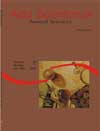<b>Productive and qualitative traits of elephantgrass (<em>Pennisetum purpureum</em> Schum.) clones evaluated under grazing conditions at Pernambuco’s coastal zone</b> - DOI: 10.4025/actascianimsci.v26i2.1858
Abstract
The objective of this research was to select elephantgrass clones for grazing conditions. A randomized complete block design was used, with 16 treatments and four replications. Each plot had a total area of 25m2, with the presence of animals. The following parameters were determined: leaf blade accumulation rate (LBAR) above 40cm height and total, stem accumulation rate (SAR), total forage accumulation rate (TFAR), dry matter concentration (%DM), crude protein concentration (%CP) and, neutral detergent fiber (%NDF). The results showed significant difference (P<0.05) between clones and evaluation periods for LBAR above 40cm, total LBAR and TFAR, with mean values of 28.08, 41.62 and 49.18kg/ha/day, respectively. Crude protein and NDF differences (P<0.05) were also found between the clones for all the different parts of the analyzed plant. The forage lost presented a similar chemical composition to the leaf blades above 40cm and to the post-grazing residue. The clones CE-08-AD and Venezuela AD presented a high performance considering the evaluated parameters and may be considered as promising materials.Downloads
Download data is not yet available.
Published
2008-04-09
How to Cite
Freitas, E. V. de, Lira, M. de A., Dubeux Júnior, J. C. B., Santos, M. V. F. dos, Mello, A. C. L. de, Tabosa, J. N., & Farias, I. (2008). <b>Productive and qualitative traits of elephantgrass (<em>Pennisetum purpureum</em> Schum.) clones evaluated under grazing conditions at Pernambuco’s coastal zone</b> - DOI: 10.4025/actascianimsci.v26i2.1858. Acta Scientiarum. Animal Sciences, 26(2), 251-257. https://doi.org/10.4025/actascianimsci.v26i2.1858
Issue
Section
Animal Science
DECLARATION OF ORIGINALITY AND COPYRIGHTS
- I Declare that current article is original and has not been submitted for publication, in part or in whole, to any other national or international journal.
The copyrights belong exclusively to the authors. Published content is licensed under Creative Commons Attribution 4.0 (CC BY 4.0) guidelines, which allows sharing (copy and distribution of the material in any medium or format) and adaptation (remix, transform, and build upon the material) for any purpose, even commercially, under the terms of attribution.
Read this link for further information on how to use CC BY 4.0 properly.
0.9
2019CiteScore
29th percentile
Powered by 








































